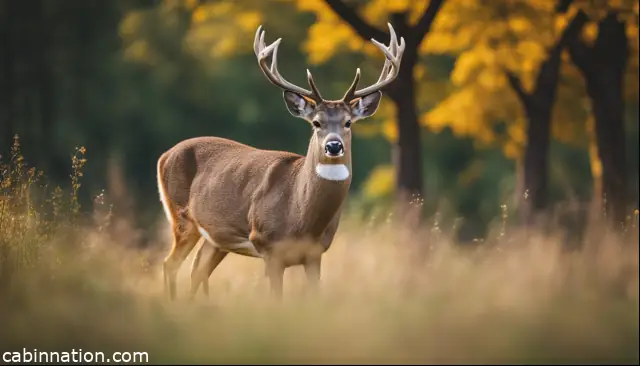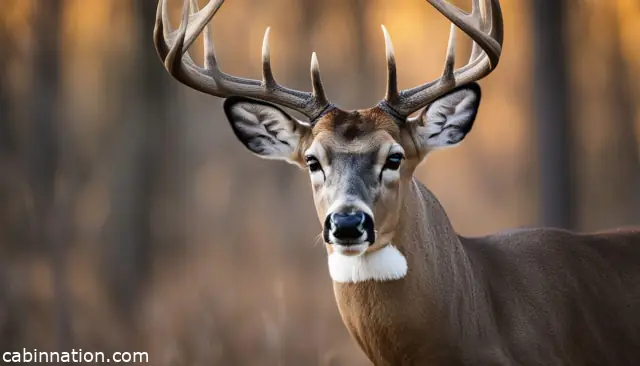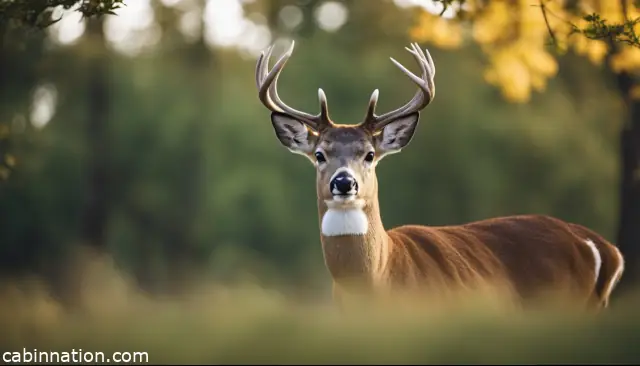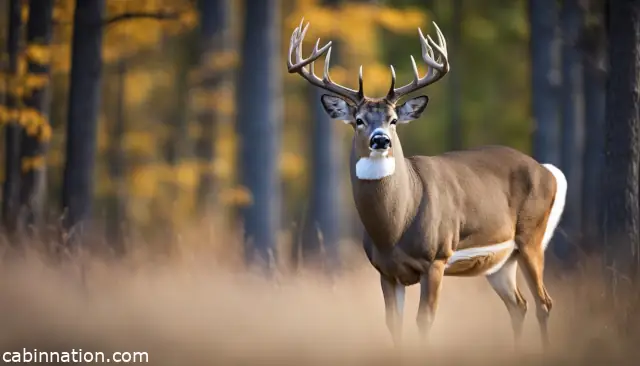Deer sounds are an important aspect of the animal’s communication and behavior. These sounds are used to convey information about their location, social status, and potential threats in their environment. There are a variety of deer sounds that serve different purposes at different times of the year.
Contents
Understanding Deer Sounds
By listening to and analyzing deer sounds, we can gain valuable insights into the animal’s behavior, community, and habitat. Additionally, hunters can use deer sounds to attract and locate their prey, and use them to identify and observe deer in the wild.
Types of Deer Sounds
Grunt Sounds
Grunting is a common form of communication among deer. There are various types of grunts such as the social grunt, contact grunt, doe grunt, buck grunt, and trailing grunt.
The social grunt is a casual sound made by deer when interacting with each other, while the contact grunt is a softer sound made when seeking the attention of a specific individual.
Doe grunts are the sounds female deer make to communicate with their fawns, whereas buck grunts are made by male deer to communicate their dominance during mating season.
Trailing grunts are a series of low, quick grunts made by bucks when chasing a doe.
Bleat and Bawl
Bleats and bawls are other vocalizations used by deer to convey their emotions and intentions.
Doe bleats are soft, high-pitched calls which females use to communicate with their offspring.
Estrus bleats, on the other hand, are longer, more drawn out calls doe make when they are in heat, signaling to bucks that they are receptive to mating.
Bawls, such as the buck bawl, are distress calls made by deer when they feel threatened, frightened, or uncomfortable.

Snorting and Wheezing Sounds
Snorting is a warning sound made by deer when they sense danger. It is produced by forcefully blowing air out of the nose, usually accompanied by intense staring and repeated stomping of the feet.
The snort-wheeze is another sound made by deer, typically by dominant bucks. It is a combination of a snort and a wheeze, used to challenge rival bucks and assert territorial control.
Other Unique Deer Sounds
A buck roar is an aggressive, guttural sound made by an angry or frustrated buck. Scream, groan, and breeding bellow are less commonly heard deer noises, expressing discomfort, pain, or distress.

Deer Sounds in Different Situations
Deer Sounds During the Rutting Period
During the rutting period, deer sounds tend to revolve around mating and establishing dominance. Bucks will grunt and snort-wheeze to display their dominance and signal their intent to challenge other males.
Grunts can vary in intensity, with some being more aggressive and forceful. As bucks engage in combat, you may also hear clashing antlers and aggressive body movements. These noises play a crucial role in the establishment of hierarchy within the herd.
Does in heat may emit bleats or high-pitched vocalizations, signaling their readiness for mating. During the pre-rut phase, these calls can serve to bond with nearby bucks and communicate contentment.
When nursing fawns, a mother may use gentle mews or grunts to call or soothe their young, showcasing nurturing and protective behaviors.
Whitetail Deer Sounds When Sense Danger
When deer sense danger or potential predators in the woods, their sounds will change to reflect fear, territorialism, and an urge to protect themselves or their young.
If a deer feels threatened, it may let out a loud bark, alerting others in the area of potential danger. Snorts are also common and can indicate either curiosity or a warning signal, depending on the situation.
The stomping of hooves can also be an indication of perceived danger, as deer may use this noise to attract attention from other deer or to ward off predators. Territorial deer may snort-wheeze as a means of asserting their authority and to express frustration.
When feeling scared or threatened, fawns will let out a cry or distress call, which may sound like a bawl, communicating their need for help or protection. This, in turn, might prompt a swift, protective response from their respective mothers, chasing off potential threats.
Understanding Deer Behavior Through Sounds
Sounds of Fawns and Does
Deer possess a wide range of sounds to communicate with one another. Fawns, for instance, can bleat when they are hungry or in distress. This soft, high-pitched sound allows their mothers to locate and tend to them quickly.
Additionally, does, or female deer, communicate through various vocalizations, such as grunts, bleats, and mews to alert others in the herd of potential dangers or to stay cohesive as a group.

Sounds of Bucks
When it comes to bucks, or male deer, their vocalizations play a crucial role during the mating season. A commonly recognized sound is the tending grunt, which bucks emit to attract females or to signal their dominance over rivals.
This low, guttural noise has different variations depending on the situation. For example, a buck might make a more aggressive grunt when challenging a rival.
Bucks also use other unique sounds to express dominance and attract females, including snorts, wheezes, and even antler rattling. These sounds can signify that a buck perceives a potential intruder or is marking its territory to protect potential mates.
Aggressive bucks may engage in antler clashes during sparring, producing loud cracking noises to demonstrate their physical strength.
The Science Behind Deer Vocals
I have noticed over my years deer hunting that deer have a range of vocalizations to communicate with one another. These sounds help deer relay information about potential danger, their mood, and their status within their social group.
By understanding these noises made by deer, we can better appreciate their complex social interactions and gain valuable insights into their needs and behaviors.
A common vocalization that deer make is the grunt, which is often heard in the woods during hunting seasons or while observing deer in their natural habitats.
Deer use grunting as a standard form of communication for various purposes, including expressing their feelings during social interactions. There are different variations of grunts, each with slightly different sounds and meanings.
Another sound that deer make is the bleat. Bleating is a way for deer to express their emotional state and signal their location to other deer.
Doe bleats are typically associated with maternal calls to their fawns, while fawn bleats can signal distress or a need for attention from their mothers.
The snort is a vocalization made when a deer senses potential danger. A snorting deer will often stomp and flag its tail to alert others to the presence of a threat. This is an essential sound to recognize for hunters, as it can indicate that they have been spotted by their prey.
Deer can also make a variety of other sounds, such as growling, to express their emotions and talk with other deer.
Listening carefully to the different deer sounds they make can provide valuable information about their environment, behavior, and individual needs. Each sound serves a unique purpose in helping deer communicate and navigate their social networks.
Deer Grunt, Bleat, Wheeze Sounds in Hunting
Attracting Deer Using Sounds
As a hunter, I am aware that effectively attracting deer can often spell the difference between a successful hunt and a fruitless one. Utilizing deer sounds to attract target animals is an essential strategy for me.
I have noticed that deer, particularly bucks, rely on grunts and snorts to communicate with each other, making the buck grunt sound an effective tool for luring them closer to my hunting location.
In addition to grunts, another powerful attractor is doe bleats, which signal a doe’s readiness to breed and can be particularly effective during the mating season.
I have had success by mimicking these sounds using deer calling devices, such as cans, which can attract both bucks and does in search of mates.
Interpreting Deer Sounds for Successful Hunting
For me, knowing how to interpret deer sounds in the field significantly increases my likelihood of spotting and tracking them down. By paying close attention to different vocalizations, I can often determine if a deer is alarmed, searching for a mate, asserting dominance, or feeling threatened.
Some common deer sounds that I have learned to recognize include:
- Sniffing and stomping: Deer may stomp and sniff the ground in response to potential danger or an unfamiliar scent.
- Snorting: A sharp snorting noise usually indicates an alert deer that has detected my presence and may warn others of potential danger.
- Whining and wheezing: These sounds can signify distress or pain, possibly due to injury or illness.

Hunting Gear for Deer Sounds
Equipping myself with the right hunting gear is crucial in making my deer hunting experience more effective and efficient. Some essential gear that I find useful for producing and recognizing deer sounds includes:
- Deer Call Devices: Deer calls, such as grunt tubes and doe bleat cans, help me imitate the various sounds deer make. They enable me to attract deer to my location or determine their position in relation to mine.
- Rattle Bags or Antlers: Rattling is an effective technique for mimicking fights between bucks, drawing those wanting to assert their dominance. Rattle bags or antler replicas can be used to create this sound.
- Tree Stands: Installing a well-placed tree stand allows me to observe deer from a high vantage point while minimizing disturbances. This strategic positioning helps me better identify deer movements and the sounds they make.
